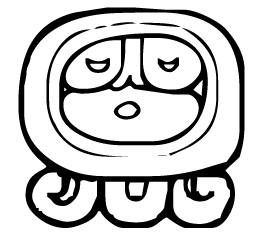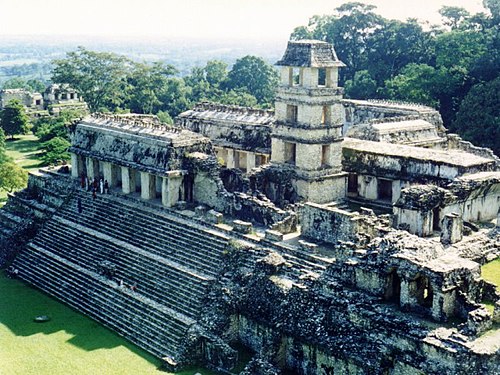
Year 683 (DCLXXXIII) was a common year starting on Thursday of the Julian calendar. The denomination 683 for this year has been used since the early medieval period, when the Anno Domini calendar era became the prevalent method in Europe for naming years.

Sak Kʼukʼ also known as Muwaan Mat, Lady Sak Kʼukʼ and Lady Beastie, was queen of the Maya city-state of Palenque. She acceded to the throne in October, 612 and ruled until 615.
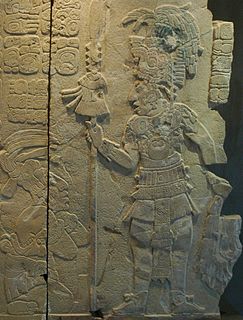
Kʼinich Kan Bahlam II, also known as Chan Bahlum II, was ajaw of the Maya city-state of Palenque. He acceded to the throne in January, 684, several months after the death of his father and predecessor, Kʼinich Janaab Pakal I and ruled until his death.

Ajen Yohl Mat also known as Aj Neʼ Ohl Mat, Ac Kan and Ahl Lawal Mat, was an ajaw of the Maya city-state of Palenque. He acceded to the throne on January 1, 605 and ruled until his death. He was probably son of Yohl Ikʼnal or Sak Kʼukʼ and brother of Janahb Pakal or Kʼinich Janaab Pakal I. During his reign, his kingdom was invaded on April 4, 611 by Scroll Serpent, ruler of the Kaan kingdom (Calakmul).

Yohl Ikʼnal, also known as Lady Kan Ik and Lady Kʼanal Ikʼnal, was queen of the Maya city-state of Palenque. She acceded to the throne on December 23, 583, and ruled until her death.

Kʼinich Ahkal Moʼ Nahb III also known as Chaacal III and Akul Anab III,, was an ajaw of the Maya city of Palenque. He took the throne on 30 December 721, reigning until c.736.

Alberto Ruz Lhuillier was a Mexican archaeologist. He specialized in pre-Columbian Mesoamerican archaeology and is well known for leading the National Institute of Anthropology and History (INAH) excavations at the Maya site of Palenque, where he found the tomb of the Maya ruler, Pakal. Ruz Lhuillier is sometimes referred to as the "Hitchcock of Archaeology".

Kʼinich Kʼan Joy Chitam II, also known as Kan Xul II and Kʼan Hokʼ Chitam II, October 31, 644 – c.721, was an ajaw of the Maya city of Palenque. He took the throne on May 28, 702 (9.13.10.6.8), reigning until c.721. He succeeded his elder brother Kʼinich Kan Bahlam II. Their father was Kʼinich Janaab Pakal I, who had ruled for 68 years, and their mother was Lady Tzʼakbu Ajaw. His possible brother could be Tiwol Chan Mat. Kʼinich Kʼan Joy Chitam apparently reigned for about nine years. He was captured by the Toniná in 711 and was possibly executed by their leader, Kʼinich Baaknal Chaak or was later restored to his kingship. He was succeeded in late 721 by Kʼinich Ahkal Moʼ Nahb III.

Maya kings were the centers of power for the Maya civilization. Each Maya city-state was controlled by a dynasty of kings.Also the position of king was usually inherited by the oldest son.

"Casper", also known as 11 Rabbit,, was an ajaw of the Maya city of Palenque from August 9, 435 to 487. He was the immediate successor of K'uk' Bahlam I, who founded the ruling dynasty.

During the 7th and 8th centuries in Mesoamerica, there was an evident shift in the roles women played in ancient Maya society as compared with the previous two centuries. It was during this time that there was a great deal of political complexity seen both in Maya royal houses as well as in the Maya area. Warfare was a significant factor in political competition and marriage was one of the ways that alliances were made between the different polities. This was accompanied by a shift in women's roles from wife and mother to playing integral parts in courtly life, such as participating in rituals involving the supernatural world and at times ruling individual polities.
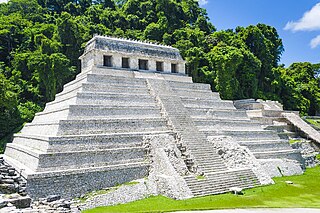
The Temple of the Inscriptions is the largest Mesoamerican stepped pyramid structure at the pre-Columbian Maya civilization site of Palenque, located in the modern-day state of Chiapas, Mexico. The structure was specifically built as the funerary monument for K'inich Janaab' Pakal, ajaw or ruler of Palenque in the 7th century whose reign over the polity lasted almost 70 years. Construction of this monument commenced in the last decade of his life, and was completed by his son and successor K'inich Kan B'alam II. Within Palenque, the Temple of the Inscriptions is located in an area known as the Temple of the Inscriptions’ Court and stands at a right angle to the Southeast of the Palace. The Temple of the Inscriptions has been significant in the study of the ancient Maya, owing to the extraordinary sample of hieroglyphic text found on the Inscription Tablets, the impressive sculptural panels on the piers of the building, and the finds inside the tomb of Pakal.

Itzam Kʼan Ahk II, also known as Ruler 4, was an ajaw of Piedras Negras, an ancient Maya settlement in Guatemala. He ruled during the Late Classic Period, from 729–757 AD. Itzam Kʼan Ahk II ascended to the throne following the death of Kʼinich Yoʼnal Ahk II. Itzam Kʼan Ahk II may have fathered the following three kings of Piedras Negras: Yoʼnal Ahk III, Haʼ Kʼin Xook, and Kʼinich Yat Ahk II. Following Itzam Kʼan Ahk II's demise, he was succeeded by Yoʼnal Ahk III in 757 AD. Itzam Kʼan Ahk II left behind several monuments, including stelae at Piedras Negras and a large mortuary temple now known as Pyramid O-13. In addition, the details of his life and his Kʼatun-jubilee were commemorated on Panel 3, raised by Kʼinich Yat Ahk II several years following Itzam Kʼan Ahk II's death.
Kʼan Moʼ Hix,, was a nobleman of the Maya city-state of Palenque. He was husband of Sak Kʼukʼ, queen of Palenque, and father of Kʼinich Janaab Pakal I, who was one of the greatest rulers of Palenque and was responsible for the construction or extension of some of Palenque's most notable surviving inscriptions and monumental architecture. He could be a possible father of Ajen Yohl Mat.
Janaab Pakal III, also known as 6 Cimi Pakal,, was an ajaw of the Maya city of Palenque. He acceded to the throne in November, 799. He was probably last ruler of Palenque and his glyph name comes from blackware vase found in the residential quarter of city.

Kʼinich Kʼukʼ Bahlam II, also known as Bahlum Kʼukʼ II and Mahkʼina Kuk,, was an ajaw of the Maya city of Palenque. He acceded to the throne on March 4, 764 and ruled until c. 783. He was a son of Kʼinich Ahkal Moʼ Nahb III and Lady Men Nik. Knowledge of him is limited to a few broken monuments: the Tablet of the 96 glyphs, the Creation Tablet, the House B Mural? and Bodega no. 218.

Kʼinich Kan Bahlam III,, was an ajaw of the Maya city of Palenque. He ruled c.751. Ruler is not mentioned in any monument at Palenque but only one text at Pomona, that suggest his reign was short or troubled.
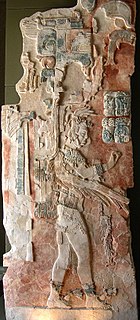
Kʼinich Janaab Pakal II, also known as Upakal Kʼinich,, was an ajaw of the Maya city of Palenque. He ruled c.742 and he was probably brother of Kʼinich Ahkal Moʼ Nahb III. There are only few details about his reign like Bodega no. 1144 and portraits on a stucco-covered pier from Temple 19, only date from his reign is from 742, when he installed lord into important office.

